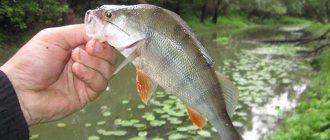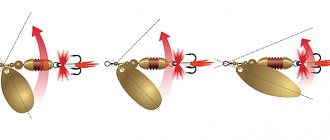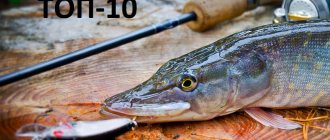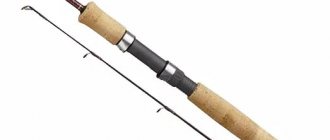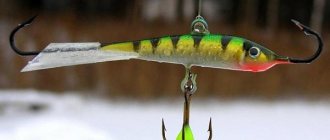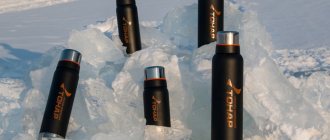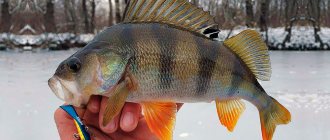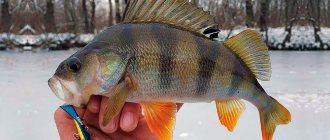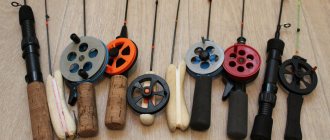Why do some anglers successfully catch perch and pike using a balance beam, while others wander from hole to hole and, without waiting for a bite, change the tackle to a more familiar one - a jig or a “float”?
In such cases, it is believed that the lucky ones have some special expensive bait with the selected size and color.
There is a grain of truth in this. But the main reason lies elsewhere. Any fishing bait begins to work only if time has been spent fishing and, as a result, faith in it has developed.
There is nothing to hide, when I started fishing with a balance beam, I had the image of “working” and “non-working” models in my head. It was difficult to eradicate the thought. Especially when experienced fishermen claimed that something specific and always a certain color works on the reservoir.
I have long ago made it a rule that when I want to catch a wobbler, I take a new pinocchio and a couple of already tested ones with me when fishing. I devoted two or three races to the new product. As a result, the wobbler ended up in the main box, or went to the bench “until requested.”
The approach to the balancer also worked. At first, my hands reached out to proven nozzle-free jigs. Everyone around me has already lost their minds, but I have a complete zero. But out of principle and harm, he continued to rinse the brought “Chinese”.
At some point, I began to imagine the movements of the balancer underwater and try to correct them with a fishing rod. Maybe the perch was tired of looking at my perversions or my hands began to move correctly, but things went well. Understanding what was happening with the bait in the water column allowed me to catch perch on par with everyone else the next day.
Of course, the performance qualities of a balancer depend on the characteristics (color, size, structure), but since I had a meager choice, I can confidently say that the determining factor is the skill and faith of the fisherman.
What is a balancer
In most cases, ice fishing balancers are made of heavy metal alloys (lead, tin or copper). The metal is cast in the shape of a small fish. Thus, the cargo imitates the main prey of predators.
The fish has a tail (for better balancing in the water), two fastenings (for tying the main line and tee) and two standard hooks.
When played and rigged correctly, this simple design realistically depicts the movement of a wounded fry. The movements are especially noticeable in cold, clear water and attract predators even from a great distance. That is why these baits are so catchy.
Balancer for perch
The choice of balancers for perch should also be approached carefully. First of all, you need to take into account the size of the predator that lives in the reservoir. Medium-sized perches are more often caught on balancers with numbers from 2 to 7. Of course, a large perch can also react to a small bait, but it is more appropriate to use larger balancers. It’s even better to take baits of different sizes with you.
If there is a strong current in the area of the reservoir where you are going to fish, you should select a narrow-bodied balancer. This choice is due to the fact that larger baits are more likely to scare away predators and often twist the fishing line. That is why, for fishing in places with strong currents, it is better to use narrow-bodied baits no larger than No. 7 (Rapala numbering).
Read about balancers for pike perch in a separate article “balancers for pike perch.” In the article you will learn a lot of useful information, a rating of balancers, as well as an educational video from the Shcherbakovs.
Kinds
These baits come in many varieties designed for specific conditions.
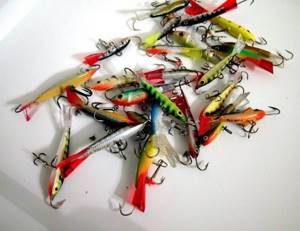
Main classification parameters:
- presence or absence of blades;
- weight and size;
- form;
- color;
- suspension equipment;
- country of origin, brand and price category.
During fishing, several factors often coincide that influence fishing tactics. Therefore, the classification of these gears is very conditional.
Most quality samples are suitable for a variety of situations. At the same time, quality is not always identical to price.
In some situations, good bites come from both expensive branded models and simple homemade ones. And sometimes there are cases when even the best fishing gear cannot save your fishing.
Yet certain types of baits often show greater effectiveness in the conditions for which they are intended. When going fishing, it is difficult to predict the situation that you may encounter. Therefore, it is advisable to have several types of balancers and understand their main differences.
Types of balancers
In addition to the classic ones, there are many different balancers that have proven their effectiveness. These balancers have the same lead body and are attached approximately at the center of gravity to the fishing line. However, there are slight differences in the game.
Balance sticks
These are all kinds of balancers such as the “Gerasimov balancer”, “black death”, etc. They have a thin and long body, a relatively flat or cylindrical abdomen and a slightly pronounced bend in the upper part.
During the game, such a balancer has a large deviation to the side even with a slight jerk, and a strong jerk is not needed here. The balancer has low resistance and with a rough jerk the operation will be disrupted. He will fly up and play incorrectly.
On the contrary, with a sufficiently soft jerk the balancer will deflect very widely and return to its original position smoothly.
Fin type balancers
Almost all balancers used by Russian fishermen are Lucky John products. However, they are not the discoverers of balancers. Initially, products from the Rapala company appeared. They had a more flattened shape than the Lucky Johns.
Apparently, following the traditions of this Finnish company, a series of “Fin” balancers appeared. They have a wide, smooth action, but are also harder to hit vertically if you push too hard. Large fins produce an almost symmetrical figure eight in the water, but a small balancer is usually placed on the perch.
Their main drawback is the very fragile attachment of the tail, which with this shape is more difficult to attach than to a classic balancer, since the contact area of the glue is smaller.
Solid tail balancers
Their tail is soldered into the body and continues through the entire body of the balancer. As a result, it is almost impossible to break. Although this is a joke, anything can be broken. Many products from Surf, Kuusamo and a number of others have exactly this look.
They are better suited for fishing in grassy, snagged areas where you have to work a lot with the unhooking. Also, do not worry about the tail falling off if the balancer is dropped from a height onto ice chips.
Many people use this technique because they are too lazy to clean the hole so that the balancer passes through it.
Due to the fact that they have a metal tail, their balance is slightly different from the classic one. Here the attachment point to the fishing line is greatly shifted forward to maintain the same game.
This is explained by the fact that the plastic tail has greater buoyancy than metal, and in water you have to slightly move the center of the balancer back so that it stands horizontally.
With a metal tail there is no such need.
Amphipod balancers
The amphipod bait appeared in the fisherman’s arsenal not so long ago. In fact, the amphipod works as a balancer. It is a flat plate with a hole, which is mounted on a hinge with an eye in the center.
In the water, the fisherman pulls it up, the bait plays: the amphipod moves to the side and in a wide arc, sometimes making two or three turns.
The amphipod is not an amphipod in the traditional sense. This is an ordinary balancer, but its tail is located in a triangle not with the tip up, but to the side. This results in a game that is not purely up and down and sideways, but also in a circle.
Victoria Leshchenko
I've been working hard in the fishing tackle department for the past six years. I can help you assemble almost any gear.
Ask a Question
Last year I had to fish with this release from the Kuusamo company, it’s not bad, but a little expensive.
Tumbling balance beams
Probably, many companies produce them, but I was able to find them on sale only from the Aqua company in St. Petersburg: this is an Acrobat balancer. According to the manufacturers, it is aimed at the North American market, but it works great here too.
In the water it performs a characteristic somersault, does not require a strong jerk and works great in the dead of winter. Its disadvantage is perhaps the small amplitude of the game, which reduces the efficiency of finding fish.
It also collects less herbs, apparently due to its shape and play, but more often it catches the hooks in the fishing line.
Presence or absence of blades
Balancers do not necessarily have to have plastic blades, it can be a tail made of silicone or feathers. Very often, experienced fishermen divide balancers on this basis, since the game directly depends on whether they have blades. Tackles with blades are designed for more active retrieves than those without blades.
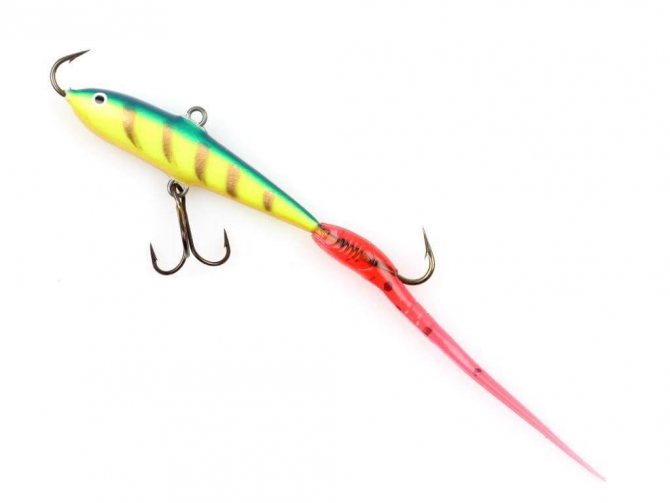
The plastic tail helps stabilize the ironfish in the water and smoothes out small errors in balancing. Gear without blades does not have such an assistant, so it must be perfectly balanced. Otherwise, the game will scare away the predator.
Most bladeless fish also have a tail, but it is made in the form of hair plumage. Its disadvantages include the inability to stabilize the load in case of weight imbalance and frequent frostbite at low temperatures. However, it gives the movements of a quality bladeless bait smoothness and naturalness.
Bladeless ironfish vary in weight, since the place and period of use of the gear depends on this parameter.
Tackle with blades
Weights with a plastic tail for additional stabilization are most common. Therefore, they have long been associated with the standard type of these baits. Most fishermen, when asked what a balancer looks like, describe blade models.
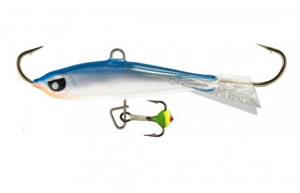
First of all, they are intended for aggressive play during periods of greatest predator activity. However, many high-quality models also work in the dead of winter, when the fish become more cautious and go to the bottom.
There are many types of wiring for bladed specimens. They vary depending on the purpose, from the most aggressive for coastal bass fishing to the slow and smooth ones for walleye fishing.
Although the tail smooths out minor imbalances, it is recommended to check your gear before fishing. A significant imbalance in weight can negatively affect the game and deprive the angler of bites. There are special specimens with a heavier front part, designed for vertical play near natural obstacles (coastal bushes, snags and tree branches).
Combined
Some models combine plastic blades and wool tails. They have their own unique game. The blades improve balance when moving parallel to the bottom, and the tail allows for smooth turns.
As a result, high-quality tackle produces fast eights even with a slight rise, which is good for attracting predators in early winter during periods of greatest activity.
Sets of high-quality combined balancers are quite rarely available in stores. Many fishermen make their own by adding blades to the hair tail (and vice versa). The main thing is to maintain the necessary proportions so that these elements do not interfere with each other when moving.
Lungs without blades
They are used at shallow depths (up to 3 meters) in the coastal zone. The size of the tackle varies from 3 to 6 cm, with a weight of up to 7 grams.
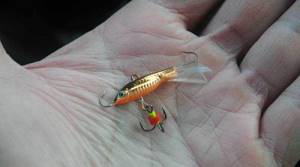
With proper weight distribution, these rigs best represent the movement of a wounded fry in shallow water. As a result, all passing predators peck at them. There is a chance of bites even in the middle of winter, when most of the fish go deeper.
The main maneuvers with this load are performed smoothly, with slight acceleration on the rise and a leisurely descent to the bottom. It is advisable to check the movements of the gear before the main fishing. A bathtub filled with water or a small pond is suitable for this.
Heavy bladeless
Light bladeless gear is not suitable for fishing at significant depths. To do this, you need a heavier load (weighing 7 grams or more). They are mainly used during the dead of winter, when most large fish live at the bottom of the reservoir.
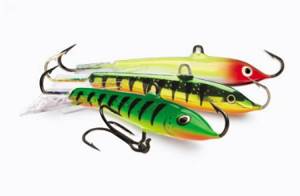
The wiring of heavy bladeless specimens is basically similar to that of light ones. They consist of smooth ascents and leisurely descents to the bottom, which alternate with fairly long pauses.
Fishing with heavy specimens requires more serious equipment (strong rod, thick fluorocarbon line, leader and reliable hooks). Otherwise, a large predator may break loose and leave with the bait in its teeth.
Silicone and plastic
There are also more non-standard varieties of this gear, made of plastic and silicone. They are designed for active fishing at depths of up to 3 meters.
Silicone specimens are practically not used at great depths, since they are not capable of showing realistic play under high pressure. In addition, large predators living on the bottom, such as pike, can easily ruin the soft material.
The wiring of silicone and plastic fish is in many ways similar to jigs - sharp, carried out at a small amplitude, with trembling and frequent tapping on the bottom.
Balancer selection
Selection of balancer and fishing line *In order for the balancer to be catchy and have a good play in the water, attracting a predator, it must meet certain requirements. If the bait jumps and makes vague, chaotic movements, it is unlikely to be catchy.
- The balancer suspended on a fishing line should have a slight tilt (up to 10°) towards the tail, that is, slightly raise the nose. For small balancers this roll is usually greater, for large ones it is less. A suspended balance beam in water should take an almost horizontal position. When swinging the fishing rod, the balancer should go as far to the side as possible, and the greater the deviation, the more catchy the bait, since it will fish a larger area.
- The tail or stabilizer also has an impact on the balancer's play. The shape of the tail makes the bait play smoother, but this applies to soft tails made of fur. Balancers with soft tails are especially effective during the dead winter period. However, the most popular are balancers with plastic stabilizers, as they allow you to fish a larger area. There are baits without tails, but they are less catchy.
- When purchasing a balancer, you need to pay attention to the quality of installation of the tail and the absence of distortions. Otherwise, the bait will not work properly.
- When choosing a balancer, you need to take a closer look at the quality of the hooks and the correctness of their installation. Hooks must correspond to the size of the balancer and have a tip slightly bent from the body of the bait, and also be in a vertical plane with the tip up and not protrude far beyond the bait.
- There are models where the front hook is turned pointing down. Such balancers are good for fishing in shallow water, since when the hook hits the lower edge of the ice, it does not deform. The catchability of the bait is not reduced by this arrangement.
- The central hanging hook (tee) can be with a fly, a colored droplet or without a replant. With a good bite, various jewelry on the hook can further increase the catchability of the balancer; if the bite is bad, some anglers recommend adding a worm, maggot, etc. The hanging hook makes additional oscillations during fishing, to which the predator responds well. Due to this, hanging hooks account for the majority of bites. The most active predator is caught on the front and rear hooks.
- It would be a good idea to pay attention to the quality of the loop with which the balancer is attached to the fishing line. If the bait is tied directly to the fishing line, then the loop should be free of burrs and defects. Otherwise, a break and loss of the balancer with fish is guaranteed.
Color selection
With a huge variety of colors of balancers, natural colors that imitate fry of roach are popular, to which the predator almost always reacts well. But balancers of fancy colors are no less catchy. For a novice fisherman, we can recommend natural colors.
In recent years, many models of balancers with holographic coating have appeared. Such baits are most catchy in clear water, at dusk and when fishing at great depths. In the morning and evening twilight, balancers of bright colors have proven themselves well. It has been noticed that baits with a red tail have more bites on the back hook than those with a colorless tail. For catching pike perch at great depths, balancers with a fluorescent color will be catchy. The classic color is “red head” - a red head; such a balancer will be good for both pike and pike perch.
Tips for choosing the color of the balancer are rather arbitrary. On any fishing trip, you always need to experiment to decide what shape and color of the balancer will be the most catchy for a given case.
Selection by external characteristics
In addition to the presence of blades, these baits are also divided according to a number of characteristics, such as color, shape and size. This mainly applies to the lobed species, since they are more common.
When choosing gear with a certain characteristic, you need to consider how it affects the effectiveness of fishing in a particular situation.
Size and weight
The length of the balancer is always proportional to the size of the expected prey. For small predators, such as perch, baits up to 6 cm are intended. In the case of catching pike or pike perch, a length of 7 cm is required.
When choosing a weight, it is necessary to take into account the depth of the reservoir. Below is an approximate ratio:
- reservoir depth up to 3 meters - load weight up to 3 g;
- 3-5 meters - up to 6 g;
- 5-7 meters - from 5 to 8 g;
- from 8 meters - from 9 g and more.
These indicators are very conditional. The choice of the required weight can also be influenced by the strength of the current, soil composition, temperature and water transparency.
Some anglers believe that paddle balancers of any weight are ineffective in depths greater than 8 meters. However, there are now a number of models with plastic blades specifically designed for deep sea fishing.
Form
This aspect determines the movement of the load in the water and the overall course of the game.
Classic iron fish with narrow noses and evenly distributed weight are used in large spaces. They describe wide figure eights, producing sweeping vibrations. In cold, clear water, these baits are able to attract predators at a maximum distance.

Fish with a larger head and weight shifted to the front are used for aggressive vertical retrieves. They can be used in the coastal zone, near snags and frozen bushes. They are indispensable where the classic sweeping game carries a high risk of getting caught on foreign objects.
Curved fish are also used for vertical play, but unlike large-headed fish, they sink to the bottom faster. Sometimes the prey bites precisely after such movements.
Heavy humpback baits are used mainly at great depths. Their main targets are large pike perch and pike that have sunk to the bottom. They are characterized by leisurely movements with smooth swaying and long pauses between movements.
Color
Many fishermen debate whether color affects bites. There is an opinion that various colors are created only to attract buyers.
Many anglers prefer certain colors, believing that predators are more likely to bite on them. This is confirmed by statistics from various competitions.
For example, during the day in some reservoirs, silver colors are more effective, as they play well in the light. And at night, at depth, it is better to use brighter acidic shades.
The optimal solution, suitable for various conditions, is considered to be a color that imitates the natural color of the main prey of a predator. These can be gray-silver colors with elements of red (imitation of a roach), dark stripes (like a perch fry) or a greenish-gray color (the color of a crucian carp).
Color is not a determining factor in successful fishing. And yet this element is important, as it complements the overall image of the bait, making it more natural in the eyes of a predator.
Hooks and tee
When choosing gear, you need to pay attention to the steel from which the hooks are made. Poor quality samples may bend or break even with light pressure. If the hooks are not sharp enough, you can sharpen them at home.
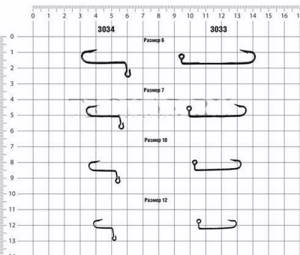
Mostly predators cling to the tee. Therefore, you need to pay special attention to this element. The harness should not fit closely to the belly. Otherwise, the fish simply won’t be able to take it. To increase the distance, small transition connections are used, like a simple carabiner.
You can decorate the tee with beads or bright multi-colored cambrics. In low light conditions, pendants equipped with special phosphor elements are used.
Balancers
Those balancers that are most often found on the Russian fishing market (regardless of the manufacturer) have mainly three design varieties. These are metal models with plastic wings in the tail, then the same ones, but with a fur tassel instead of wings, and, finally, silicone balancers on a metal frame, which appeared relatively recently. There are also combinations of a woolly tail with wings, but these are already derivative designs. The plastic tail, after moving the balancer forward, slows it down - and it turns 180°. The bait should not move backwards, always only with its nose forward. A completely different story with a hairy tail . When moving backwards, it fluffs up, begins to slow down the movement of the balancer there - and the bait turns around. Through experiments, the developers found out that such qualities are not inherent in the fur of every animal. And the triangular wings are well balanced for vigorous twitching - and the bait can "jump" without losing its balance. The use of a combined tail is nothing more than an attempt to ensure a faster turn of the bait.
At dusk, bright colors are more effective. In clear water, darker colors can be used. Brownish water should also have brown tints.
Small baits are not used at depths of more than 5 m. At shallow depths, small perches are more common, so it is better to use small baits. Depending on the phase of the season (beginning or end of winter), the technique of “playing” with a balancer is modified. This is due to the fact that the behavior of fish itself changes in different periods. At the end of winter , for example, perch are the hungriest - and therefore more aggressive. And, accordingly, the wiring of the bait should be very energetic - to give it an intense “game”. And, conversely, at the beginning of winter , smaller baits are used and the “play” with them is less intense. In spring , it is better to fish in the middle layers of water, using balancers 8 cm long and giving them a powerful upward movement.
It is also important that in the spring there is more light, then the perch notices the bait from a greater distance.
"Game" of the balancer
First you need to touch the bottom, hit 5-6 times, raise the bait higher and let it stop. After a short pause, toss it several times and raise it even higher. The fish usually follows the bait, and when the balancer rises higher, it begins to take. If you are fishing for pike, then the twitching should be much calmer, but for perch it should be sharper: the stroke is small, but sharp.
It is necessary to alternate the pace, because with the same type of wiring the chances of success are much less. On huge bodies of water, such as the Gulf of Finland or Lake Ladoga, it is best to fish with sharper twitches. After hitting the bottom three or four times, sharply lift the bait, stop - and at this moment a bite may follow. The balancer must maintain a horizontal position and rotate in the upper phase. When you pull it, it should rise up and to the side. When you lower it, it should turn with its nose forward - and fall into place. The bait is specially made so that you feel when it turns.
Tips for beginners
First you just need to visually study the movements of the bait. This can be done even in winter, better - at shallow depths, through a hole: exactly how the bait deviates, turns around, goes the other way and turns around again. Feel how each phase of the “game” is transmitted along the line, and when the “game” itself fades away. There is nothing complicated.
In the spring, due to the activity of the fish, the pause in the retrieve may be shorter - and you practically do not allow the balancer to stop.
At the beginning of winter , the fish are still inactive, it is more difficult to catch them, but there are small tricks that are appropriate to use. The perch grabs its prey like a pike - swallowing it completely. It grabs the bait in the middle, while opening its mouth, as if drawing in water - and with it the prey. And if in the spring he does this aggressively, at the beginning of winter he sometimes moves the bait a little. This feature can be taken into account and used by equipping the balancer with a tee with a long forend in low-bite situations. Due to its light weight and length, it has a greater chance of getting into the fish’s mouth when the bait remains in place. In addition, it is large and yellow, and fish pay attention to the yellow color. The rule is always true - at the beginning of winter the tee is longer, in the spring - shorter. For greater attractiveness, you can take a long hook with a droplet. And if you only use a short tee, sometimes attaching a worm to it gives good results. But you can fish without it.
Balancers with a fur tassel on the tail
As mentioned above, these baits are recommended for catching small fish at shallow depths. For these balancers, a quiet “game” is recommended, because when thrown sharply, such a bait can turn over with its belly up, which will lead to wiring failure. When the balancer is pulled upward, it moves to the side with its nose forward (the tail plays the role of a rudder), and after stopping, it tends to take its original position. The bait meets the resistance of the brush, which fluffs up (expands) as it moves backwards, the balance bar turns around its horizontal axis - and rushes forward with its nose to its original position (the tail again acts as a rudder).
Balancers with fur tassel and flat plastic tail
Let me first note that here and below we give examples of models with tails made of plastic, as the most common ones, but this is also true for those whose tails are made of light metals. It is believed that metal fletching is less likely to break when the bait is tapped on the bottom. To be fair, it should be said that leading manufacturers pay great attention to this, and although plastic tail breaks do occur, they are extremely rare.
The principle of operation of baits of this type is very similar to that of the previous one. A significant improvement is that the plastic tail plays a stabilizing role when throwing the bait sharply, preventing it from turning over and maintaining balance for heavier baits. This model uses its wings to glide and return to its original position. This ability is useful to use when fish are biting passively, for example, at the beginning of winter.
Balancers with classic triangular tail
They differ mainly in body shape and proportions. At the same time, ideal balance is a prerequisite for all of them; in other words, when suspended, the balancer must take a strictly horizontal position.
Now - about the body shape of the bait. The most significant difference that affects the nature of the “game” is the shape of the nose. Using the example of the Nils Master the game of baits with increased, i.e. weighted head. By the way, Hannu Lindroos developed his new balancers precisely according to this design principle.
When you throw such a bait up in the water, the shape of the tail helps it make a sufficient deflection to the side (and exactly in the direction where the head is turned), while maintaining a horizontal position. At the moment of weakening of the traction force and the natural tendency of the balancer to go down, the tail, due to greater resistance, slows down, rises, and at the same time the balance is upset, and thanks to the weighted head, a quick and sharp somersault of the bait occurs - and the head changes places with the tail. The plumage, sensing the resistance of the water, levels the bait horizontally - and it rushes to its original position with its nose forward. In this case, the tail plays the role of a rudder, preventing the balancer from deviating from straight-line movement.
Narrow-nosed balancers work on the same principle, but basically, instead of a sharp somersault, they flip over, making the movement along a more rounded trajectory. Nils Master weighted balancers from the Shad series operate similarly. Taking this into account, it is better, after throwing the bait 5-10 cm, to lower the tip of the rod, allowing the bait to make a smooth maneuver without a sharp push. With a very sharp toss, these balance beams can also make a somersault, but this is no longer the norm of behavior.
A traditional vertical lure is fundamentally different from others in that it plays during its vertical movement in the water and after short strokes of the rod during fishing. Depending on the depth of fishing, the thickness of the fishing line, and the activity of the fish, each spinner has its own game and spinner technique during the fishing process.
The body shape of the spinner, its mass and the location of the center of gravity are selected in such a way that the spinner, when immersed, moves away from the vertical, that is, it glides. If the spinner repeats the same movements during the fall from swing to swing, then such a spinner should be considered “working”. Moreover, it will be “working” wherever fishing conditions allow its use.
If the spoon behaves differently on each fall and glide, and even more so if it “goes into a tailspin” during the fall, then there is no need to talk about its catchability. You can roughly check the behavior of the spinner in a bath of water. Roughly, because at depth, due to the resistance of the fishing line in the water, the spoon will play smoothly and slowly. But if a spinner plays well in a bath of water, then it will almost certainly play well in a pond.
It is very important to abandon the illusion that if a “working” lure is found, then it will be universal. In your arsenal you need to have spinners of different colors, sizes and designs. It is important to choose a set and assortment of spinners that will be quite universal. The fact is that, unlike catching perch with a jig, you hunt for large perch or pike perch with a spinner.
Large perch behave differently from their small counterparts. He, like a pike, has certain feeding hours. He often gets “cranky” about the color of the spoon. Therefore, as practice shows, the assortment of spinners should be quite large (up to 30-40 pieces).
Winter spinners are often called spinners used for vertical fishing, although they are used not only for fishing from ice. They are now becoming more and more widespread during summer fishing from boats, rafts or bridges, and often vertical spinning turns out to be more successful than horizontal spinning. In a number of cases, for example, with a significant depth of the reservoir, with an uneven bottom, when fishing near underwater ledges running along the shore, among stones, sunken logs, it is very difficult to catch fish in any other way than by trolling in a plumb line.
And in winter, from ice, this method is the only possible one. Therefore, spinners for this type of fishing are often called “winter”. Winter spinners differ from summer ones in the way of fishing and “game”. When starting the retrieve, lower the bait directly to the bottom and hold it there without playing for a few minutes, then start playing by reeling in the fishing line, fishing all the water layers (horizons) down to the very bottom edge of the ice.
Raise the bait in “steps” of one meter. Fishing the entire water column is important - it is not uncommon to catch large fish at a depth of no more than 30 cm from the lower edge of the ice. After fishing the hole and not having luck, change the place. If you managed to catch a fish, then lower the bait on the next trip immediately to the “catching” depth, hold it there, and also fish adjacent horizons. If luck does not smile on you, change place. Having found a fish, catch it, and then “drill” the hole that is no longer active - the fish may be standing nearby. If you have drilled a sufficient number of holes, you can always move between them, returning again and again in search of active fish.
Playing with bait requires the most attention. If the fish is passive, then it will not chase the bait. The fish will swim around the bait, inspect it, perhaps even slightly taste it. But if your bait bounces up and down a meter non-stop when playing, forget about catching any fish. As soon as you attract the fish to the bait (this will become clear from the bite), stop the retrieve and give the fish the opportunity to look at the bait, taste it before swallowing it - and one day the fish will respond to your offer and end up on the ice.
Balancers Rapala, Nils Master
The best manufacturers
There is no one most catchy and universal model for all occasions. However, based on practice, certain baits work significantly better than others in some conditions. Quality may depend on the country of origin and the producing brand.
Finnish
Balancers from Finnish manufacturers are rightfully considered the best. Most professional fishermen use Finnish samples.
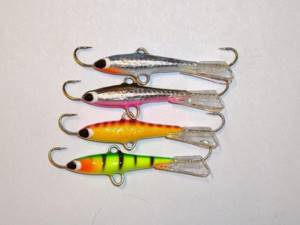
It is no coincidence that the Rapala and Karismax brands have long formed the standard classics in this industry. And manufacturers from other countries copy their designs one way or another.
Before going on sale, models from leading Finnish brands are tested for correct balance and play in the water. Therefore, they do not need any improvements after purchase. Correct weight distribution, high-quality hooks, fastenings and painting make Finnish samples the most effective for ice fishing.
The main disadvantage of these baits is their excessively high price. We must not forget that balancers are consumable fishing tools. Any underwater snags, any active predators can deprive the fisherman of valuable bait, especially with little experience in underwater fishing and poor-quality fishing rod equipment.
In addition, many stores sell fakes. They can be distinguished by a number of characteristics. For example, original Rapalas have no paint on the line and treble attachments, while fakes are often completely painted. The original box has cross-shaped cuts for better opening, which is not present on counterfeit products. A professional will also pay attention to non-original hooks and blades. However, a beginner always runs the risk of purchasing a low-quality copy at the price of the stated brand.
And yet, it is better to use Finnish balancers on an expensive professional fishing rod.
Baltic
Unlike Finnish brands, manufacturers from the Baltics, such as Lucky John, produce models at a lower cost. At the same time, the quality is not much inferior to famous competitors.
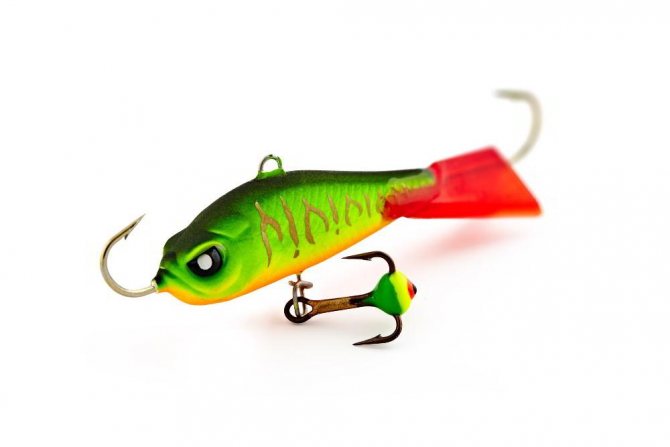
For example, on many Lucky John samples, the paint partially peels off after a few months of use, which is not significant, since preserving the gear after an active fishing season is already a great success.
Balancing and equipment of the Baltic models are performed at the proper level. Many specimens allow you to smooth out wiring imperfections, which makes them perfect for beginners.
Thus, Baltic samples are ideal in terms of price and quality ratio.
Russian
For a long time, experienced fishermen treated domestic models with disdain. However, subsequently samples appeared on the Russian market that forced fishermen to change their minds. For example, “Black Death of Gerasimov” in some conditions produces better bites than the legendary Rapala.
The undoubted advantage of most Russian samples is their cost. For example, for one price you can buy a model from the Finnish brand Karismax or six tackles from the domestic Freeway, which also attract bites. Considering the high risk of losing balance beams while fishing, for a beginner the second option seems more logical.
Chinese
Brands from China mostly copy the products of Finnish competitors. However, this does not mean that their models are not worthy of attention. For example, the Chinese Condor produces several pretty good samples that have a relatively low cost.
However, as in the case of Russian models, Chinese baits must be tested for proper balancing and quality of equipment before fishing.
Japanese
Products from Japan have always been distinguished by their quality and uniqueness. Fishing gear is no exception here. Some professional fishermen prefer Izumi brand lures to Finnish Rapala and Latvian Lucky John, considering them more catchy in some reservoirs.
However, Japanese models have a relatively high cost and are demanding in terms of wiring. Therefore, they are more suitable for experienced fishermen.
Balancer for pike
If your goal is to catch pike, you should not take a balancer that is too small. The optimal size in this case is approximately 7 cm. The color is selected individually, taking into account the natural conditions of the reservoir and the time of fishing, but it is better to use bait that resembles the color of a perch or roach.
When choosing bait for pike, be sure to pay attention to the size of the hooks. If two baits are the same size, you should give preference to the one with larger hooks. If the balancer is already equipped with a small tee, it is also better to replace the latter with a larger one.
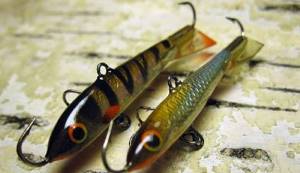
TOP 3 catchable balancers
Summarizing the information presented and reviews from many anglers, you can make a top 3 most effective models.
Rapala Jigging Rap
Classic model rapala. It is a reference model for many manufacturers of similar baits. Perfectly balanced. Has high quality hooks and fastenings.
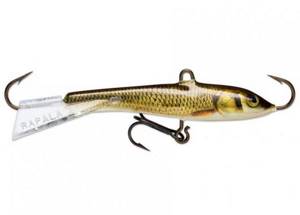
Available in various colors. It comes in six sizes and weights, making it suitable for catching most predators. Provides the possibility of aggressive or passive play depending on the activity of carnivores in winter.
Lucky John Classic
Main competitor of Rapala. It is practically not inferior to it in model design and equipment, but has a lower cost. Despite the presence of blades, it is perfectly used at great depths.
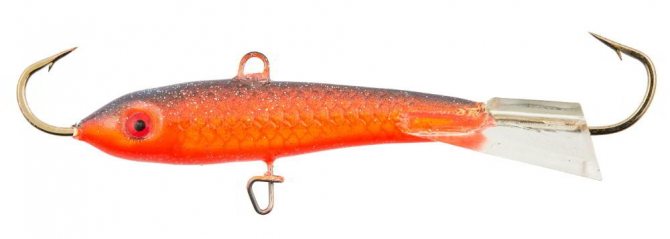
Balancer Lucky John Classic 6, length 60 mm, weight 16 g. The classic shape and proper weight distribution provide uniform movements when playing and reduce the risk of snagging on the fishing line. This model forgives many mistakes during fishing, so it is ideal for novice fishermen.
"Black Death of Gerasimov"
One of the few domestic models that can compete on equal terms with Finnish brands in terms of bite efficiency. Possesses a unique wide game at maximum amplitude, which is facilitated by uniform balance and an elongated torso.
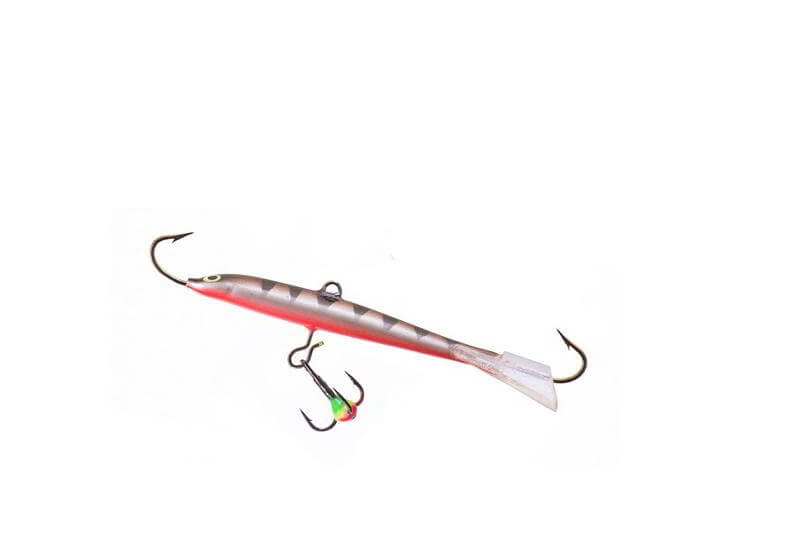
The Black Death Balancer comes in 12 different colors and two sizes.
The model is designed for guiding in open, clear water, where it can attract a predator from a distance of up to 25 meters. High-quality hooks and tees ensure reliable catching of prey.
All the gear presented above has been tested more than once in “combat” conditions. And yet you should not treat the balancer as some kind of “magic wand” that is guaranteed to bring a catch. Fishing with this bait requires endurance and a certain skill, which is acquired after several winter fishing trips. Over time, each angler himself determines the balancer that is suitable for himself.
Which fishing line to choose for the balancer
For fishing with a balancer, you should use high-quality monofilament fishing line. It is characterized by moderate stretchability, and therefore is capable of shock absorption in the event of strong jerks of the predator.
The most common line diameter when fishing with a balancer is 0.25 mm.
Thinner fishing line is very often subject to breakage, even when pulling out a small pike. But at the same time, you should not forget that in winter the pike is less careless, and therefore can notice a fishing line of large diameter. In addition, too thick a line can negatively affect the performance of the bait.
Useful article on the topic: choosing fishing line
What size balancer should I choose?
Balancers come in lengths from two to nine centimeters. The size of the balancer is usually indicated on the marking.
A misconception is that smaller balancers may be more attractive to predators. With a large balancer you can fish the largest area; with a small balancer you will catch only a small perch. If you fish at great depths, you should increase the size of the bait. The same is true when fishing in the current.

